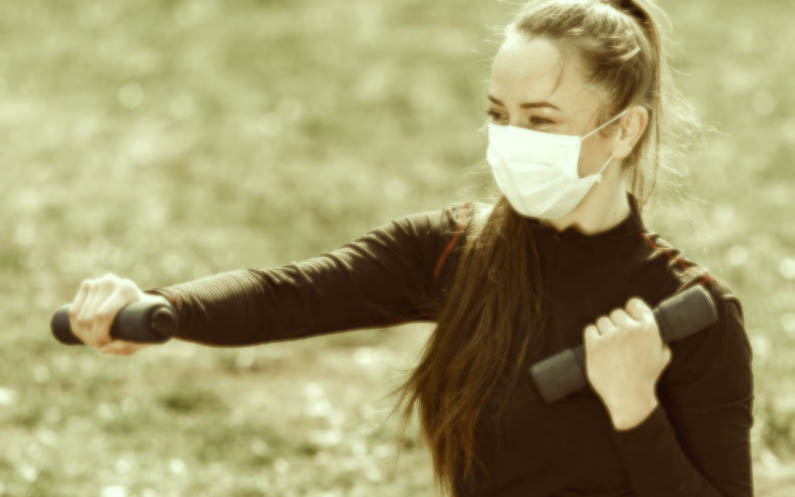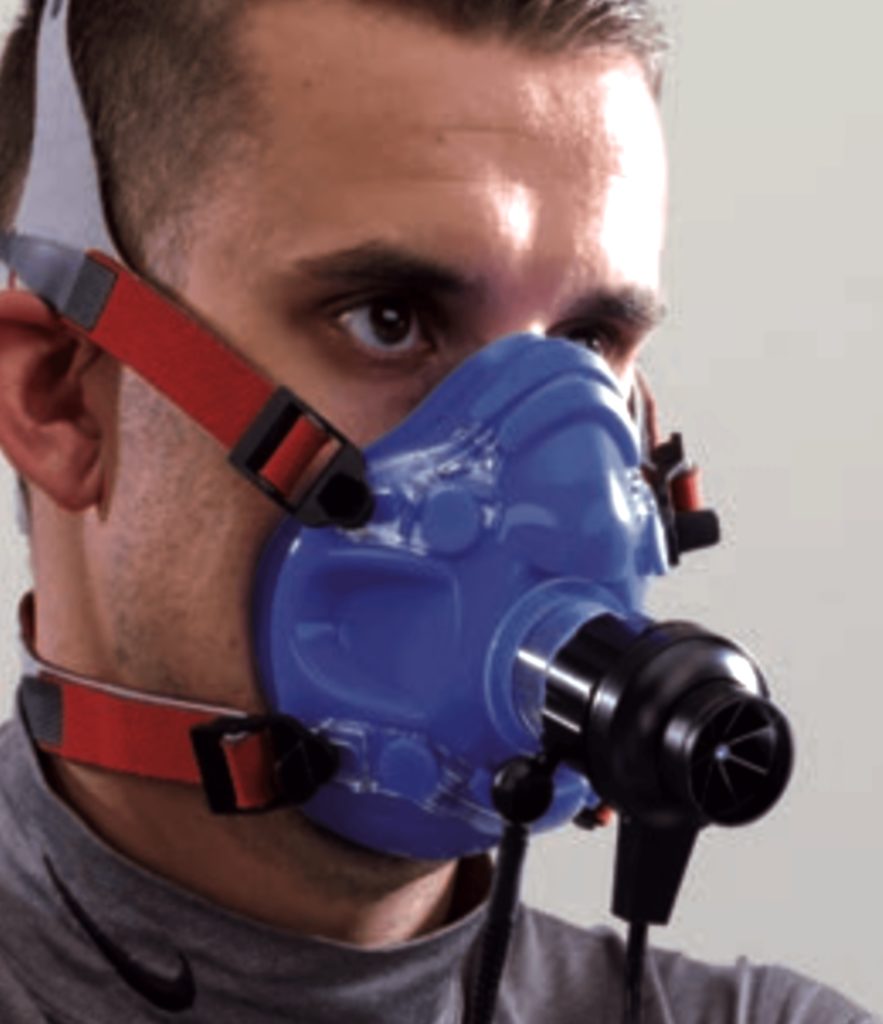Neil Wolkodoff, PhD, Medical Program Director
When exercising with a mask in cardiovascular activities, do you feel that you cannot breathe quite well and get over-heated? Fact or feeling?

Most people in the cardiovascular area of facilities are wearing a bit more clothes when it is winter, there is perceived protection from infection (long-sleeved shirt and pants), and they are also wearing a mask.
Most athletic clubs were down 30+ percent in members during Covid19. If you talk to most people, exercise in a mask in less than tolerable. So, while the air was a bit more humid than normal as described in this blog, time to set out some facts about how mask use works or doesn’t in terms of exercise.
Examining what goes on with masks in straightforward terms is both perceptions, and part of it is physiology. Furthermore, remember, all masks are not created equal in terms of protection, individual fit and physiological interaction. Masks may provide some level of protection to particles assuming all the air goes through the mask and not around it in any form. Fitting is critical.
You can breath at the same rate in a mask as without a mask at rest. At least for a short while and if respiratory frequency is limited to low-level or moderate activity. In cardio-vascular (CV) of a moderate level, airflow is low enough to go through the mask in both directions. Once a Forced Voluntary Contraction or a big exhale, at maximum speed, occurs, the mask cannot work correctly, and there is air leakage around the mask. Low-level CV activities should not be an issue with the airflow, yet activities like maximal sprints or efforts, the mask may not keep up with airflow requirements. However, there are other issues/factors which interact with the perceptions of breathing ease with a mask.
The huge issue is that face masks have dead space or trapped air that quickly does not move in and out of the mask. In this regard, masks for Covid-19 are very similar to the masks used in VO2 testing and those worn by firefighters and other first responders in dead space. VO2 testing usually is 13-19 minutes. Firefighters practice with the mask and respiratory requirements, so a bit of short time frame or being accustomed to the breathing system’s feelings and performance and having to wear their gear.

The dead space around a mask, where air does not flow in or out immediately, means the Carbon Dioxide, or CO2 level will be higher around the mask. There have been reports of some people essentially experiencing a panic disorder partially triggered by the additional CO2. In general, panic attacks trigger shorter and less complete breathing, which further worsens the situation.
Now add to this fact the mouth and face connect somewhere between 30-39% of sensory and motor nerves. In other words, small things seem pretty big when applied to the face and mouth. Moisture around the mask enhances sensory perception. Furthermore, with those having or on the borderline of Chronic Obstructive Pulmonary Disorder (COPD), the mask may push up the feeling of CO2 level another notch due to the condition. Perception and feeling do change respiratory or breathing mechanics. Some have postulated in this sense, masks contribute to hyper ventilation.
Another co-contributor to this feeling of reduced breathing is simply the mask, and in almost any porous material, retains more moisture in the breathing process as time goes on. Humidity and heat have a relationship that as moisture rises, the perception of heat index goes up. The “I Can’t Breath Feeling” has some basis in reality, and the higher moisture levels around the mask elevate perception. And moisture does affect permiability. Take walking through an airport with baggage with a coat on. Even a short to moderate walk could do it based upon temperature. Likely that humidity is up, and it won’t take long before the humidity gain in the mask reduces the permeability to the point all the airflow is through the sides and around the mask.
What are simple steps to ease both the perception and physiology of the mask toleration point in exercise?
Make your own assessment if the mask really does any good, as the data is conflicting as to benefit.
First, wear a fresh mask when exercising, so there is no residual moisture from anything earlier in the day.
Ask the gym to turn down temperature two or three degrees in the CV area to take down the heat index by the mask.
Emphasize nasal rather than mouth breathing.
Use a dynamic warm-up or increase in intensity or speed to enable respiratory rate to increase slowly over the first five minutes.
If the perception is still present after 20 minutes, consider a break to somewhere to remove the mask for up to a minute or two to allow both CO2 and humidity to dissipate.
Carry a personal towel and wipe off the face and forehead every 10 minutes during exercise.
Bring a second mask to the exercise session and change out at 20 minutes to a new dry one.
References
Amirav I, Newhouse MT. Dead space variability of face masks for valved holding chambers. Isr Med Assoc J. 2008;10(3):224-226.
Davies A, Thompson KA, Giri K, Kafatos G, Walker J, Bennett A. Testing the efficacy of homemade masks: would they protect in an influenza pandemic?. Disaster Med Public Health Prep. 2013;7(4):413-418. doi:10.1017/dmp.2013.43
Faruque Ahmad M. A Novel Perspective Approach to Explore Pros and Cons of Face Mask in Prevention the Spread of SARS-CoV-2 and other pathogens [published online ahead of print, 2020 Dec 31]. Saudi Pharm J. 2020;10.1016/j.jsps.2020.12.014.
Freemas JA, Wilhite DP, Greenshields JT, Adamic EM, Mickleborough TD. Comparison between a facemask and mouthpiece on breathing mechanics and gas exchange variables during high-intensity exercise. Eur J Sport Sci. 2020;20(2):211-218.
Furutani Y, Shiigi T, Nakamura H, Nakamura Y, Ishizaki H, Uchiyama K, Harada M, Shimizu A, Matsuzaki M. [Influence of the dead space induced by the face mask on the measure of heart rate variability]. J Cardiol. 1997 Mar;29(3):171-6. Japanese. PMID: 9095448.
Kyung SY, Kim Y, Hwang H, Park JW, Jeong SH. Risks of N95 Face Mask Use in Subjects With COPD. Respir Care. 2020;65(5):658-664.
Li DF, Cadnum JL, Redmond SN, Jones LD, Donskey CJ. It’s not the heat, it’s the humidity: Effectiveness of a rice cooker-steamer for decontamination of cloth and surgical face masks and N95 respirators. Am J Infect Control. 2020;48(7):854-855.
Parlin AF, Stratton SM, Culley TM, Guerra PA. A laboratory-based study examining the properties of silk fabric to evaluate its potential as a protective barrier for personal protective equipment and as a functional material for face coverings during the COVID-19 pandemic. PLoS One. 2020;15(9):e0239531. Published 2020 Sep 18.
Roberge RJ, Kim JH, Coca A. Protective facemask impact on human thermoregulation: an overview. Ann Occup Hyg. 2012;56(1):102-112.
Scarano A, Inchingolo F, Lorusso F. Facial Skin Temperature and Discomfort When Wearing Protective Face Masks: Thermal Infrared Imaging Evaluation and Hands Moving the Mask. Int J Environ Res Public Health. 2020;17(13):4624. Published 2020 Jun 27.